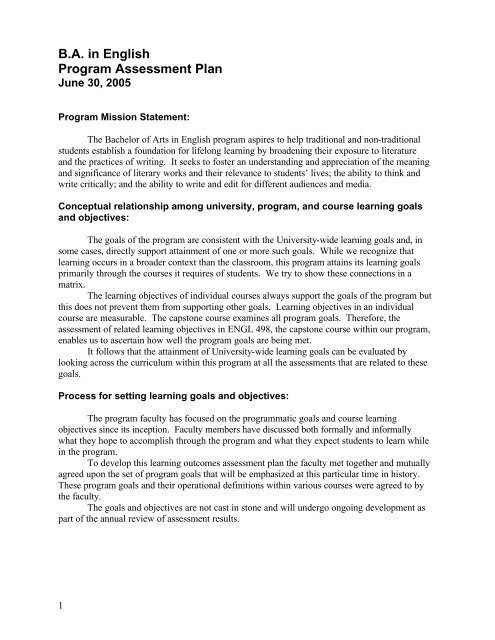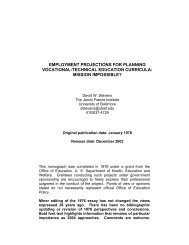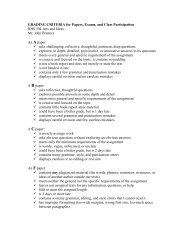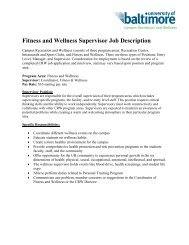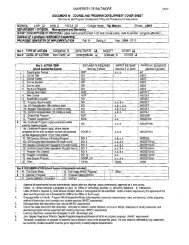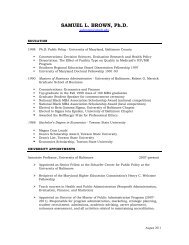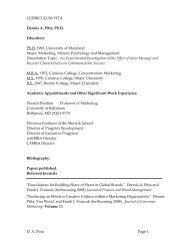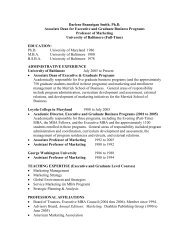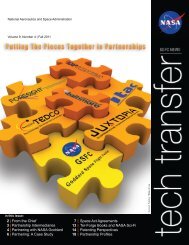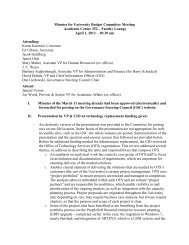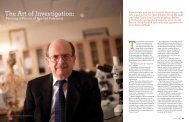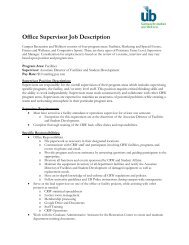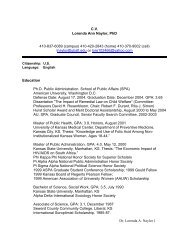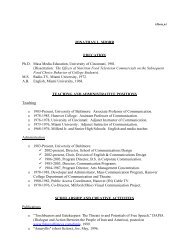B.A. in English Program Assessment Plan
B.A. in English Program Assessment Plan
B.A. in English Program Assessment Plan
Create successful ePaper yourself
Turn your PDF publications into a flip-book with our unique Google optimized e-Paper software.
B.A. <strong>in</strong> <strong>English</strong><strong>Program</strong> <strong>Assessment</strong> <strong>Plan</strong>June 30, 2005<strong>Program</strong> Mission Statement:The Bachelor of Arts <strong>in</strong> <strong>English</strong> program aspires to help traditional and non-traditionalstudents establish a foundation for lifelong learn<strong>in</strong>g by broaden<strong>in</strong>g their exposure to literatureand the practices of writ<strong>in</strong>g. It seeks to foster an understand<strong>in</strong>g and appreciation of the mean<strong>in</strong>gand significance of literary works and their relevance to students’ lives; the ability to th<strong>in</strong>k andwrite critically; and the ability to write and edit for different audiences and media.Conceptual relationship among university, program, and course learn<strong>in</strong>g goalsand objectives:The goals of the program are consistent with the University-wide learn<strong>in</strong>g goals and, <strong>in</strong>some cases, directly support atta<strong>in</strong>ment of one or more such goals. While we recognize thatlearn<strong>in</strong>g occurs <strong>in</strong> a broader context than the classroom, this program atta<strong>in</strong>s its learn<strong>in</strong>g goalsprimarily through the courses it requires of students. We try to show these connections <strong>in</strong> amatrix.The learn<strong>in</strong>g objectives of <strong>in</strong>dividual courses always support the goals of the program butthis does not prevent them from support<strong>in</strong>g other goals. Learn<strong>in</strong>g objectives <strong>in</strong> an <strong>in</strong>dividualcourse are measurable. The capstone course exam<strong>in</strong>es all program goals. Therefore, theassessment of related learn<strong>in</strong>g objectives <strong>in</strong> ENGL 498, the capstone course with<strong>in</strong> our program,enables us to ascerta<strong>in</strong> how well the program goals are be<strong>in</strong>g met.It follows that the atta<strong>in</strong>ment of University-wide learn<strong>in</strong>g goals can be evaluated bylook<strong>in</strong>g across the curriculum with<strong>in</strong> this program at all the assessments that are related to thesegoals.Process for sett<strong>in</strong>g learn<strong>in</strong>g goals and objectives:The program faculty has focused on the programmatic goals and course learn<strong>in</strong>gobjectives s<strong>in</strong>ce its <strong>in</strong>ception. Faculty members have discussed both formally and <strong>in</strong>formallywhat they hope to accomplish through the program and what they expect students to learn while<strong>in</strong> the program.To develop this learn<strong>in</strong>g outcomes assessment plan the faculty met together and mutuallyagreed upon the set of program goals that will be emphasized at this particular time <strong>in</strong> history.These program goals and their operational def<strong>in</strong>itions with<strong>in</strong> various courses were agreed to bythe faculty.The goals and objectives are not cast <strong>in</strong> stone and will undergo ongo<strong>in</strong>g development aspart of the annual review of assessment results.1
<strong>Program</strong> Learn<strong>in</strong>g Goals:Upon graduat<strong>in</strong>g from the B.A. <strong>in</strong> <strong>English</strong> program students will possess:1) An ability to analyze and <strong>in</strong>terpret literary works <strong>in</strong> an <strong>in</strong>sightful and persuasive way.2) An ability to write effectively for particular purposes, audiences, media, and/orpublication contexts.3) An ability to revise and edit their own and others’ writ<strong>in</strong>g.4) An ability to see significant connections and differences between texts, authors, genres,styles, and periods of literary history.5) An ability to understand the relation between texts and relevant contexts (e.g. literary,rhetorical, historical, cultural, technological).Courses Incorporat<strong>in</strong>g Learn<strong>in</strong>g GoalsCont<strong>in</strong>ued2
3Courses Incorporat<strong>in</strong>g Learn<strong>in</strong>g Goals, Cont’d.
Guid<strong>in</strong>g pr<strong>in</strong>ciples for assessment:- The program is committed to assessment and to development of a unified, coherentprogram to evaluate its educational activities.- The program values the <strong>in</strong>volvement of all students and faculty <strong>in</strong> the assessmentprocess.- The faculty of the program, given their accountability for the curriculum, haveprimary responsibility for the development and implementationof assessment activities.- Statements of desired educational objectives of the program shall orig<strong>in</strong>ate with, and beapproved by, the faculty of the program.- Student learn<strong>in</strong>g will be assessed us<strong>in</strong>g both direct and <strong>in</strong>direct methods andquantitative and qualitative data.- The non-aggregated data gathered for assessment purposes shall rema<strong>in</strong> confidentialand shall be used only for the purposes of assessment.- <strong>Assessment</strong> of student learn<strong>in</strong>g outcomes is about improv<strong>in</strong>g learn<strong>in</strong>g, not evaluat<strong>in</strong>gfaculty.- <strong>Assessment</strong> is systematic, ongo<strong>in</strong>g, and cyclic.- <strong>Assessment</strong> will be simple, doable, and consistent with the university’s mission.- The assessment program is dynamic and will evolve over time.Projected <strong>Assessment</strong> Activities: Year 1Course-Level Learn<strong>in</strong>g Objectives4
Indirect method of measur<strong>in</strong>g atta<strong>in</strong>ment of program goals:In addition to the learn<strong>in</strong>g objectives assessed by the course objectives and rubrics listedabove, learn<strong>in</strong>g goals are also <strong>in</strong>directly measured through an Undergraduate Exit Survey mailedby the College of Liberal Arts to graduat<strong>in</strong>g students, <strong>in</strong> all programs, each semester (Summer,W<strong>in</strong>ter, and Spr<strong>in</strong>g). This general survey attempts to obta<strong>in</strong> <strong>in</strong>formation about atta<strong>in</strong>ment ofcompetencies thought to be important for students <strong>in</strong> all discipl<strong>in</strong>es. In particular, thesecompetencies are related to University Learn<strong>in</strong>g Goals and help establish whether students arereach<strong>in</strong>g these goals.Along with the general survey, each graduat<strong>in</strong>g student also receives a program specificsurvey which <strong>in</strong>cludes items that measure competencies related to their major discipl<strong>in</strong>e.Beg<strong>in</strong>n<strong>in</strong>g <strong>in</strong> August 2005 this survey will reflect the program learn<strong>in</strong>g goals agreed upon byfaculty and listed <strong>in</strong> this assessment plan.How results will be used to improve student learn<strong>in</strong>g:The faculty will meet at least once each year to review the outcomes of assessment, tocompare outcomes to pre-established standards, and to decide on an action to be taken. This<strong>in</strong>formation will be conta<strong>in</strong>ed <strong>in</strong> the annual assessment report.Some possible actions are:- No action is required; students are meet<strong>in</strong>g the standard.- No action is required at this time; explore more fully the reasons why students didn'tmeet standard.- Increase the standard (e.g., from 75% to 80%)- Determ<strong>in</strong>e why there are such differences among the various sections of a course forwhich measurement has occurred.- Redesign the rubric/measurement tool; it does not seem to be measur<strong>in</strong>g what we desire.- Work together as a faculty to redevelop the pre-requisites for a course; problems appearto be due to lack of preparation.- Meet as a faculty to discuss ways to teach a specific concept that seems to be elud<strong>in</strong>gour students.Timel<strong>in</strong>e for what will be measured and schedule of exam<strong>in</strong><strong>in</strong>g/report<strong>in</strong>g results:Year OneDevelop the first assessment plan.Detail the plan fully for the Capstone Course.Complete the assessment of two goals for this course.Meet to discuss the results of this assessment and determ<strong>in</strong>e what action, if any, will be taken.File first report with University <strong>Assessment</strong> Committee by February 1, 2006.Year TwoRevisit the assessment plan and make any necessary revisions.Detail the plan fully for the rema<strong>in</strong><strong>in</strong>g goals of this course.Complete the assessment of these goals.Meet to discuss the results of this assessment and determ<strong>in</strong>e what action, if any, will be takenFile report with University <strong>Assessment</strong> Committee by February 1.5
Timel<strong>in</strong>e, cont’d:Year ThreeDeterm<strong>in</strong>e what, if any, assessment will take place outside Capstone Course.If so, detail more fully.Who is responsible for plan implementation:The Faculty <strong>Program</strong> Director is responsible for implement<strong>in</strong>g the assessment plan. Heor she must see that the agreed upon time l<strong>in</strong>e is adhered to, that assessment results are compiledand reports filed with the University <strong>Assessment</strong> Committee. The program director is alsoresponsible for <strong>in</strong>tegrat<strong>in</strong>g the results of assessment <strong>in</strong>to the program and its curriculum. All ofthis will be done <strong>in</strong> a framework of collegial responsibility because the faculty, as a group, shareresponsibility for design<strong>in</strong>g and deliver<strong>in</strong>g a curriculum that achieves the program’s goals.6


